#White-spotted Sawyer Beetle
Explore tagged Tumblr posts
Text
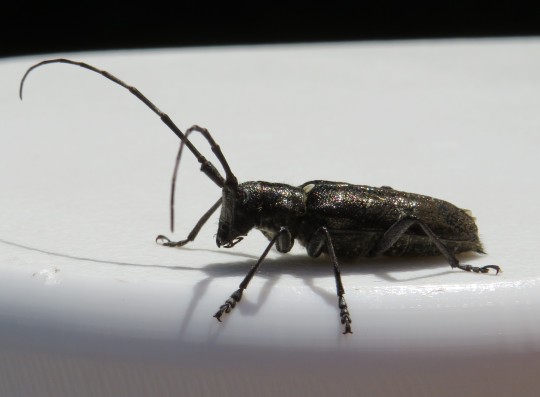
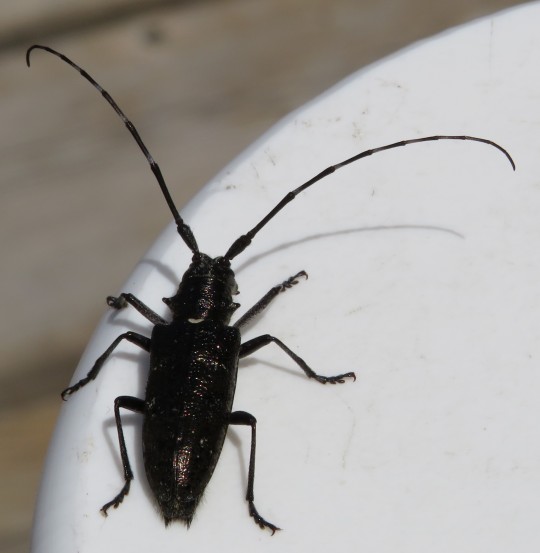
Monochamus scutellatus (male)
#White-spotted Sawyer Beetle#spruce bug#canada#my photos#ecology#native species#nature photography#wildlife#nature aesthetic#summer 2022#insects#bugblr#beetle
5 notes
·
View notes
Text



@melodraca submitted: I didn't know these guys bit until my family informed me after this one landed on me for a surprise photo-shoot 🥲 thankfully I remain bite-free
location: southern alberta
They do have mandibles that can bite, yes! But I've never been bitten. They don't have venom or anything so I can't imagine it would hurt that much beyond a sharp pinch. Handsome fella either way!
For those unaware, this is a white-spotted sawyer beetle, which is a type of longhorn beetle.
248 notes
·
View notes
Text

White Spotted Sawyer
#artists on tumblr#original photographers#original photography#hiking#pacific northwest#nature#washington#pnw#nikon#orofeaiel#beetle#insect#entomology#white spotted sawyer#wildlife#goblincore#naturecore#macro photography
35 notes
·
View notes
Text

A pixel bug background!! Intended to be seamlessly tiled. Featuring the following bugs:
A rubber ducky isopod
A garden worm
A dairy cow isopod
A north american leech
A white spotted Sawyer beetle
A carpenter ant
A june beetle
A fire ant

Example of it in use! It is super cute! I recommend you open it in a new tab to clearly see the pixel elements.
Feel free to use as a background on your carrd, spacehey, etc, with credit to my carrd here!
Reblogs preferred over likes, especially if you're gonna use it! | kofi/tipjar
#art#bugs#bugblr#bug art#insect#entomology#background#carrd asset#worm#ant#fire ant#carpenter ant#rubber ducky isopod#dairy cow isopod#isopod#sawyer beetle#longhorn beetle#leech#june beetle#june bug#drawn by: kevin
328 notes
·
View notes
Text

[click for higher resolution]
Dumb original art packed full of imagery from my childhood (spotted knapweed and white-spotted sawyer pine beetles) and some fun magical fire because I really like the pin light setting :3 yippee art
48 notes
·
View notes
Text

MS Paint fairy I drew in like 2023??? I think I named them Moss, and they’re based on a beetle, perhaps a white-spotted sawyer?? It was a very simple drawing so ignore the glaring flaws
2 notes
·
View notes
Text


I drew some fursonas + a bugsona bcuz i have no idea how 2 draw bugs. @tertiaryapocalypse 's "white-tailed deer" circut, @citrus-wall-paint as a lion, & @/cricketjuice_'s (on IG) persona as a white spotted sawyer beetle.
7 notes
·
View notes
Text
Hi! This is my pine sawyer beetle. His name is Shrimp Doria. I picked him up from the hot sidewalk a little over four weeks ago. He is invasive here, so he has been living out his days in a curry takeout container and provided with a broad variety of fresh evergreen clippings to munch. He’s active and has a good appetite still, but I’ve been noticing this odd white patch developing on his back. At first I was worried it was some kind of fungus (and maybe it still is?) but when I looked at the first photo I took of him to compare, I realized there was a MUCH fainter version in the same spot! Do you know what is going on here?


uhh i love him and he’s very cute but he just looks like a normal White-spotted Sawyer beetle to me. i’m sure hes fine!
7 notes
·
View notes
Text
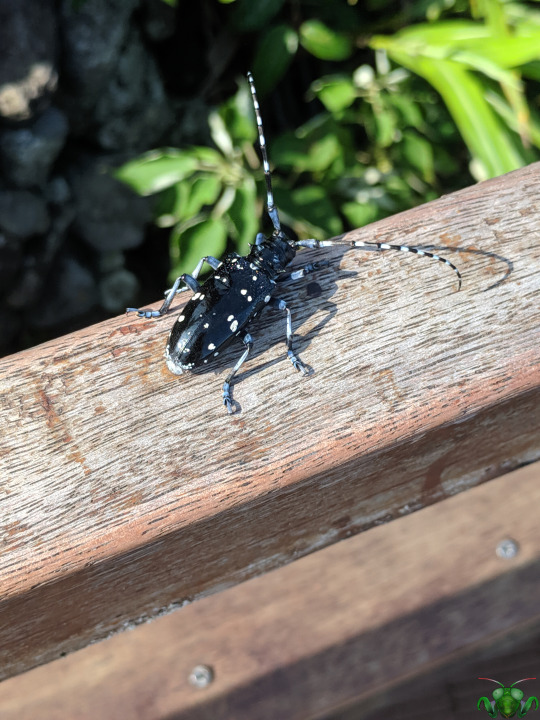

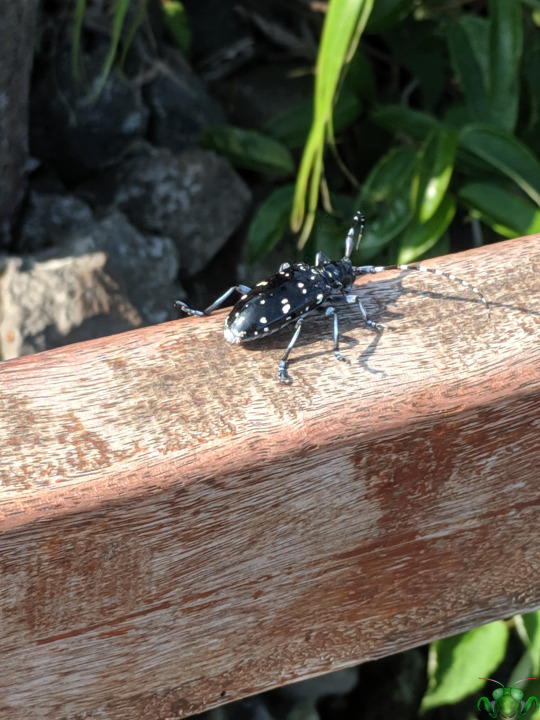
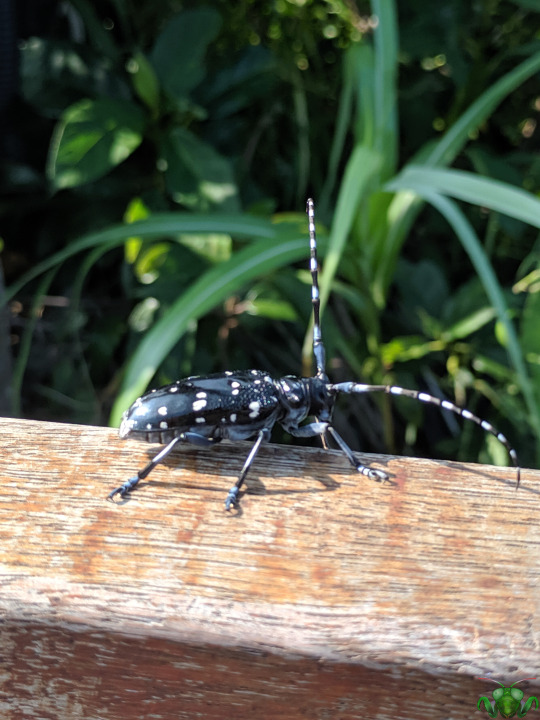



Citrus Longhorn Beetle - Anoplophora chinensis
We return to lovely Sunrise Peak in South Korea to have another look at this starry-night shelled specimen. From the initial batch sent to me, there were extra images leftover for another post, but 4 years is a long time for an update! Previously, I gushed over this find, so this post will examine more facts. The first thing I'd like to clarify is the size of this Longhorn Beetle as the images make it appear giant! The wooden beam it travels on isn't a massive rail. In actuality, specimens have been measured fall in the range of 20 - 40mm (2-4cm) long. Like their distant cousins, the red Milkweed Beetle, females tend to be larger than the males. That's just talking about body size; if antenna length was included, these insects became much longer, but in different ways. Female Citrus Longhorn antennae is just slightly longer than the length of the body, while males have antennae that are 1.5 times as long as their body (or longer)! Given the antennae length, it's likely that the individual in these pictures is a female Longhorn. In addition, the tip of the abdomen appears to be more rounded compared a male's narrowing abdomen, but I'm not relying on that as a whole since the wingcase position (having recently been opened) makes abdomen examination difficult. Secondly, all this talk about size only applies to the adults, as the larvae can get much longer, larger and heavier.
They're soft-bodied and lack some of the more sophisticated structures that the adults have, such as wings and long antennae, so they can afford it until pupation. Whichever tree specie the eggs are laid inside, the larvae begin to feed beneath the bark on the tree's pith and tissues near the base. Feeding there also allows access to tree's roots which the larvae may also feed on using gnawing mandibles. Since the larvae dwell in the bottom of the tree, feeding will eventually translate to the whole tree as nutrients are cut off and their innards become damaged and prone to arboreal diseases. What makes them so notorious as pests is that damage done tends to be invisible until the tree's health begins to deteriorate or the adult emerges from the tree, leaving behind an escape hole appears as if it was perfectly drilled from the inside. Since they can remain undetected without close inspection of trees and wood products, it's no wonder that human transport has accidentally introduced them to Europe and North America where efforts aim to contain or eradicate them. It's a shame that the larvae swarm and feed so voraciously since the adult Beetle is so ornate and eye-catching.
Furthermore, the adults only eat leaves and nibble at the outer parts of the tree. Though beautiful, we need to monitor for them and manage them carefully to prevent critical damage to trees and forest, similar to its close relative (recently eradicated in Ontario), the Asian Longhorn Beetle (Anoplophora glabripennis). We would be hard-pressed to naturalize them in a manner like the White Spruce Sawyer Beetle, especially since the latter feeds on dead wood, while the Citrus Longhorn feeds on fresh tree innards. It seems so easy at first given how similar the two species appear to each other, but it's often the details that are important with introduced species. To conclude on the subject of details, North American bug hunters should be extra observant not to confuse the White Spruce Sawyer for the Citrus Longhorn. Though both share dark-colored bodies, pronotum side-spikes and long antennae, the latter will always be more robust in shape, have a spotted wingcase and ringed antennae. If you can get close enough to the front of the wingcase, examine carefully for the presence of 2 small white tubercular structures (one on each wingcase) as these are distinctive to the Citrus Longhorn, and aren't found on the Asian Longhorn.
Pictures were taken on July 21, 2019 in South Korea with a Google Pixel. And with that, every successfully identified insect from the yearlong Asia trip has been posted! You've been amazing, my dearest Sarali! Thank you for sharing your amazing, life-changing voyage with me, and for all of these lovely creatures! Godspeed to all your future endeavors and dreams!
#jonny’s insect catalogue#asia insect#beetle#citrus longhorn beetle#longhorn beetle#insect#coleoptera#south korea#korea#july2019#2019#nature#entomology#invertebrates#arthropods#animals#photography
4 notes
·
View notes
Text

White-spotted Sawyer Beetle - August 2023 While at Wrangell - St Elias National Park, I overheard a group of people saying, “Ewww, that’s one of those long-horned beetles that is killing all the trees.” They were about to squash it when I said, “That is not a long-horned beetle.” That led to a quick discussion while two of them looked up long-horned beetles on their phones and I looked up “beetle with white spot on back.” They held up their phones and said, “See!” I held up mine and said, “A long-horned beetle doesn’t have the white spot.” They said “Oh,” and didn’t squash this rather nice-looking White-spotted Sawyer Beetle. Both beetles lay eggs in pine trees, but the Sawyer doesn’t carry the disease that kills the trees I can identify long-horned beetles because I found one on a trail in Canada several years ago and didn’t know what it was until we checked into our next campground. There was a big poster with warnings about invasive insects and there it was with its own corner. I said, “I just saw one of those on the trail.” The ranger nicely told me that they had been eradicated in the area. I didn’t argue, but after we set up, I brought back my laptop and showed her the images I had taken of a long-horned beetle sitting on a fallen tree. She called her supervisor and reported it. I don’t know what he said, but she responded, “He’s got pictures.” I ended up burning a disk for them of my entire hike so they would know exactly where I took the picture. A week later, we heard on the news that a section of forest had been intentionally burned to eradicate long-horned beetles. It was the trail I had been on. MWM
#alaska#tok ak#valdez ak#wrangell - st elias national park#pine sawyer beetle#monochamus scutellatus
0 notes
Text

I Feel Sheen by Rocco
2 notes
·
View notes
Text
Hello Hello! So, I was listening to Maggot Belly by awfultune and I was thinking about my little bug OCs. Then I thought, what would characters in Inscryption be if they were bugs? So now I have compiled a list of every character that I could possibly think of along with some research to further fit the characters. I hope you all enjoy and have a good rest of your day/night!
TW: Reference of Bugs/Spiders (just in case)
Scrybes:
P03: Morpho Butterfly
Grimora: Yellow Spotted Stink Bug
Leshy: Elm leaf beetle
Magnificus: Giant Silk Luna Moth
NPCs:
The Factory:
The Dredger: Water strider
The Inspector: Carolina mantis
The Melter: Bronze orange bug
The Forest:
The Prospector: Phidippus Otiosus Jumping spider
The Angler: Roly-Poly
The Trapper/The Trader: Leaf-footed Bug
The Crypt:
Kaycee Hobbs(Ghoul): Ground beetle
Royal Dominguez: Fruit fly
Sawyer Patel: Cicada
The Tower:
Pike Mage: European Firebug
Goobert: Geometer emerald moth
Lonely Wizard: Firefly
Uberbots:
The Archivist: Thistle mantis
The Photographer: Polyphemus moth
The Unfinished Boss: Cabbage white butterfly
G0lly: Blue bottle butterfly
Others:
The Woodcarver: Bark beetle
Rebecca: Dragonfly
The Bone Lord: White Spider
Kaycee Hobbs: House Cricket
Luke Carder: Seven-spot ladybird
#inscryption#inscryption p03#inscryption grimora#inscryption leshy#inscryption magnificus#inscryption dredger#inscryption inspector#inscryption melter#inscryption prospector#inscryption angler#inscryption trapper#incsryption trader#inscryption kaycee hobbs#inscryption royal#incryption sawyer#inscryption pike mage#inscryption goobert#inscryption lonely wizard#inscryption archivist#inscryption photographer#inscryption unfinished boss#inscryption g0lly#inscryption woodcarver#inscryption rebecca#inscryption bone lord#inscryption luke carder
21 notes
·
View notes
Note



A beautiful white-spotted sawyer found on a walk, and this lovely cat-faced spider (Araneus gemmoides) hanging out in a window. They’re super common out here and I love them to bits.
I also love them!
#dawnsiren#insects#bugs#arachnids#spider#orbweaver#cat faced orbweaver#white spotted sawyer#beetle#longhorn beetle#submission
78 notes
·
View notes
Note
This is kinda random, but are you 100% sure that's a pine sawyer beetle? It looks a lot like an asian longhorn beetle, which is super invasive where I live. Obviously idk where you live, but if you're in New England you should consider reporting that.
hahaha yeah i'm sure! to begin with, i live in the rockies. alhb haven't gotten out to me yet! but here, let me show you.


here's a comparison! you were right to notice they are a little similar -- both the alhb (left) and my pine sawyer (right) are cerambycids, which means they're both in the beetle family Cerambycidae! Cerambycid beetles tend to have a long abdomen with elytra to match; a long rectangular body-shape overall; a squared-off head, usually with high-set eyes; and long antennae -- their "long horns". here's a pic of a bunch of random cerambycids all lined up together, so you can see the similarities!

my two beetles at the top look even more similar than a lot of these grab-bag beetles because they are both beetles that bore into pine trees as larvae, and so have a lot of shape language and such in common! if you want to tell them apart, check for multi-colored spots on the elytra, thinner legs on the pine sawyer, a more matte and textured appearance overall, and the lack of stripes on the antennae :) heres a pic i found from a maine gov initiative featuring the white-spotted sawyer, a closely related species to my pine sawyer!

24 notes
·
View notes
Text
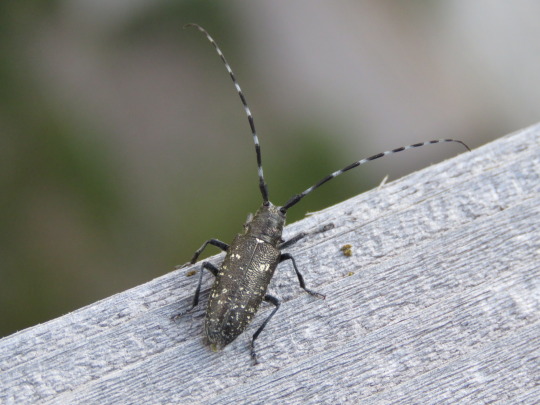
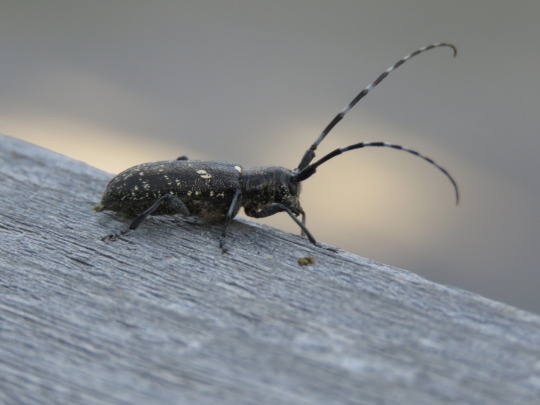
Finally trying to expand my knowledge into the beetle realm!
I believe this is a female White-spotted Sawyer Beetle, but would welcome any corrections :)
#this is the first beetle I’ve tried to identify using some of my new books#so I genuinely welcome any corrections/confirmations/information!#insect tw#beetle identification
21 notes
·
View notes
Photo
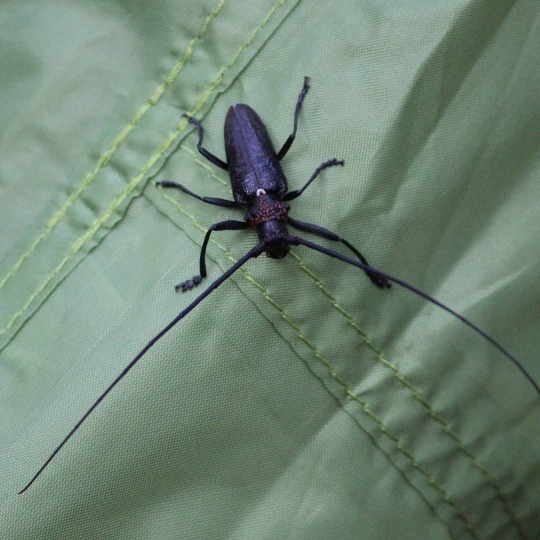
White-Spotted Sawyer Longhorn Beetle (Monochamus scutellatus) in Algonquin Provincial Park, July 2017. This individual is a male, as evidenced by the extremely long antennae (The "longhorns" of its common name). There are tiny red Mites hitching a ride on this Beetle as well. The mites are possibly of the genus Trichouropoda, and so far as I can find, we're still not exactly sure why they do this. It's likely they ride on these wood-boring Beetles to reach new habitats faster. They don't seem to be harmful to the Beetles unless there's a particularly large number of them. . . . . . . . #nature #ontario #symbiosis #phoresy #mites #phoretic #phoreticmites #monochamus #monochamusscutellatus #cerambycidae #cerambycidaebeetle #longhornedbeetle #beetlesofinstagram #woodboringbeetle #algonquinprovincialpark #algonquinpark #ontarioprovincialparks #ontarioparks #ecology #insectecology #arthropods (at Algonquin Provincial Park) https://www.instagram.com/p/CCiq-BJpxCO/?igshid=4xe3u6yche3k
#nature#ontario#symbiosis#phoresy#mites#phoretic#phoreticmites#monochamus#monochamusscutellatus#cerambycidae#cerambycidaebeetle#longhornedbeetle#beetlesofinstagram#woodboringbeetle#algonquinprovincialpark#algonquinpark#ontarioprovincialparks#ontarioparks#ecology#insectecology#arthropods
1 note
·
View note